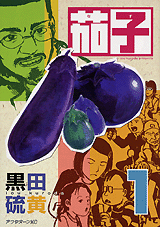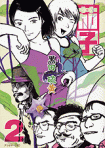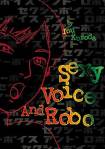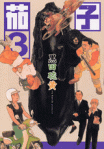 Among the things I simply don’t understand about manga is why there aren’t more titles by Ai Yazawa available in English. There are two irrefutable reasons there should be more Yazawa in more places: Paradise Kiss (Tokyopop) and NANA (Viz), the Yazawa titles that have already been licensed and translated. Paradise Kiss is a five-volume treasure about young fashion designers and their gawky, ambivalent muse. NANA is a sprawling soap opera about two young women who share the same name and are in the thick of Tokyo’s music scene. Both series are as emotionally engrossing as they are stylish, and while I’m not sure either has ever topped the sales charts (in fact, the publication of Paradise Kiss actually predated specific attention for manga on such lists), the fondness for Yazawa is palpable. (And she’s a superstar in Japan, where NANA does regularly top the sales charts and has been spun into movies, an animated series, and, unless my memory is failing me, a café.)
Among the things I simply don’t understand about manga is why there aren’t more titles by Ai Yazawa available in English. There are two irrefutable reasons there should be more Yazawa in more places: Paradise Kiss (Tokyopop) and NANA (Viz), the Yazawa titles that have already been licensed and translated. Paradise Kiss is a five-volume treasure about young fashion designers and their gawky, ambivalent muse. NANA is a sprawling soap opera about two young women who share the same name and are in the thick of Tokyo’s music scene. Both series are as emotionally engrossing as they are stylish, and while I’m not sure either has ever topped the sales charts (in fact, the publication of Paradise Kiss actually predated specific attention for manga on such lists), the fondness for Yazawa is palpable. (And she’s a superstar in Japan, where NANA does regularly top the sales charts and has been spun into movies, an animated series, and, unless my memory is failing me, a café.)
 For this week’s purposes, I’ll focus on two Yazawa titles. First up is Tenshi Nanka Ja Nai, originally serialized by Shueisha in Ribon. It spans eight standard volumes, though it’s also been collected in four double-sized books. French publisher Delcourt chose the four-volume version when it published the series as Je ne suis pas un ange in its Akata imprint. I prefer the covers of the four-volume version (example above), and I suspect I’d like the heft, so that would also be my format preference. Tenshi (or I Am Not an Angel) is described by Delcourt as Yazawa’s first major commercial success. While the synopsis at Wikipedia sounds fairly conventional – friendship, love, and jealousy in high school – I would love to see how Yazawa executes that familiar formula. (As others have noted, this is not to be confused with Takako Shigematsu’s Tenshi Ja Nai!! [I’m No Angel!!], published in English by Go! Comi and well worth your time.)
For this week’s purposes, I’ll focus on two Yazawa titles. First up is Tenshi Nanka Ja Nai, originally serialized by Shueisha in Ribon. It spans eight standard volumes, though it’s also been collected in four double-sized books. French publisher Delcourt chose the four-volume version when it published the series as Je ne suis pas un ange in its Akata imprint. I prefer the covers of the four-volume version (example above), and I suspect I’d like the heft, so that would also be my format preference. Tenshi (or I Am Not an Angel) is described by Delcourt as Yazawa’s first major commercial success. While the synopsis at Wikipedia sounds fairly conventional – friendship, love, and jealousy in high school – I would love to see how Yazawa executes that familiar formula. (As others have noted, this is not to be confused with Takako Shigematsu’s Tenshi Ja Nai!! [I’m No Angel!!], published in English by Go! Comi and well worth your time.)
 Next is Gokinjo Monogatari, also originally serialized by Shueisha in Ribon. Aside from being a Yazawa creation, Gokinjo Monogatari (or Neighborhood Story) has the added allure of being a prequel to Paradise Kiss. (Okay, maybe “prequel” is the wrong word. That’s reserved for stories set earlier in continuity than the one that spawned them, right? Then again, since it would be published in English after Paradise Kiss, it would technically count as a prequel, right? Sorry. Moving on.) Mikako, the story’s protagonist, is the older sister of Miwako, one of the designers from Paradise Kiss. It follows the lives, loves and ambitions of students at Yazawa Arts, and nobody portrays young artists quite as well as Yazawa. It spanned seven volumes, so it wouldn’t lend itself to easy doubling, but seven is a lucky number. Delcourt has also published Neighborhood Story as Gokinjo: une vie de quartier.
Next is Gokinjo Monogatari, also originally serialized by Shueisha in Ribon. Aside from being a Yazawa creation, Gokinjo Monogatari (or Neighborhood Story) has the added allure of being a prequel to Paradise Kiss. (Okay, maybe “prequel” is the wrong word. That’s reserved for stories set earlier in continuity than the one that spawned them, right? Then again, since it would be published in English after Paradise Kiss, it would technically count as a prequel, right? Sorry. Moving on.) Mikako, the story’s protagonist, is the older sister of Miwako, one of the designers from Paradise Kiss. It follows the lives, loves and ambitions of students at Yazawa Arts, and nobody portrays young artists quite as well as Yazawa. It spanned seven volumes, so it wouldn’t lend itself to easy doubling, but seven is a lucky number. Delcourt has also published Neighborhood Story as Gokinjo: une vie de quartier.
And since I’m on the subject of Yazawa, I’ll restate something I’m sure I’ve mentioned before. I would really love it if someone published a handsome omnibus of Paradise Kiss. At five volumes, it would be a bit chunky, but the story and style almost beg for high-end packaging, and it would be a great way to introduce the series to readers who may have missed it the first time around. If Tokyopop isn’t up for it, they could always partner with Dark Horse, which seems to be quite interested in repackaging super-stylish manga (mostly by CLAMP) in aesthetically worthy vessels.
 Earlier this week, Erica Friedman of
Earlier this week, Erica Friedman of  The plot involves royalty, destiny, warfare, feminism, upstairs-downstairs lesbian romance, and lots of other nifty-sounding stuff in a relatively short three volumes, originally serialized in
The plot involves royalty, destiny, warfare, feminism, upstairs-downstairs lesbian romance, and lots of other nifty-sounding stuff in a relatively short three volumes, originally serialized in  Leave it to Iou Kuroda to turn the ubiquitous, easy-to-grow fruit/vegetable into a manga series, Nasu, that I really, really wish someone would license and translate into English. It was originally serialized in Kodansha’s
Leave it to Iou Kuroda to turn the ubiquitous, easy-to-grow fruit/vegetable into a manga series, Nasu, that I really, really wish someone would license and translate into English. It was originally serialized in Kodansha’s  It was also published in French by
It was also published in French by 
 And
And 
 Many may feel that I’m squandering this week’s license request on a sure thing. There are few manga-ka who have had as much of their work translated into English as Fumi Yoshinaga, so the licensing of her current food-fixated comedy,
Many may feel that I’m squandering this week’s license request on a sure thing. There are few manga-ka who have had as much of their work translated into English as Fumi Yoshinaga, so the licensing of her current food-fixated comedy,  Quite a bit of time elapsed between publication of the third and fourth volumes of Yoshinaga’s charming high-school comedy,
Quite a bit of time elapsed between publication of the third and fourth volumes of Yoshinaga’s charming high-school comedy,  The prize went to
The prize went to 




 Many, many people wish that manga publishers would license more work from
Many, many people wish that manga publishers would license more work from  Hagio, as you likely very well know, is one of the high priestesses of the Year 24 Group. Some of her work has been published in English by Viz (They Were Eleven in
Hagio, as you likely very well know, is one of the high priestesses of the Year 24 Group. Some of her work has been published in English by Viz (They Were Eleven in  But what’s Otherworld Barbara about? For that, I was lucky to have the translation assistance of
But what’s Otherworld Barbara about? For that, I was lucky to have the translation assistance of 
 And really, why else would I request a comic that its original publisher (Shueisha) doesn’t even seem to have kept in print? I’m speaking of the three-volume Children of the Earth, written by Jinpachi (Benkei in New York) Mori and illustrated by Hideaki Hataji. I believe it was originally serialized in Shueisha’s
And really, why else would I request a comic that its original publisher (Shueisha) doesn’t even seem to have kept in print? I’m speaking of the three-volume Children of the Earth, written by Jinpachi (Benkei in New York) Mori and illustrated by Hideaki Hataji. I believe it was originally serialized in Shueisha’s  Here’s what I’ve been able to glean of the book’s plot from the remnants of my shaky college French: a newbie with Japan’s agricultural agency is sent to a rural village, Takazono, to help local farmers “reform” Japanese agriculture. The bureaucrat, Natsume, butts heads with a local farmer, Kohei, who has no use for the government’s reformation effort. Natsume is won over by Takazono’s charms and the inherent dignity of farming and dedicates himself to encouraging young people to pursue education and careers in agriculture.
Here’s what I’ve been able to glean of the book’s plot from the remnants of my shaky college French: a newbie with Japan’s agricultural agency is sent to a rural village, Takazono, to help local farmers “reform” Japanese agriculture. The bureaucrat, Natsume, butts heads with a local farmer, Kohei, who has no use for the government’s reformation effort. Natsume is won over by Takazono’s charms and the inherent dignity of farming and dedicates himself to encouraging young people to pursue education and careers in agriculture. Admittedly, the English-reading manga fan need not suffer from an absence of farming comics. The first volume of Moyasimon (Del Rey) was just listed in Previews, promising an opportunity to really get to know the microbes so essential to food production. Viz’s Oishinbo gang always seems to be ready to head out to the countryside to see food at the source. (I want their jobs and their expense accounts, don’t you?) But Children of the Earth seems like it would be right up my alley and, as I said, this is ultimately all about me.
Admittedly, the English-reading manga fan need not suffer from an absence of farming comics. The first volume of Moyasimon (Del Rey) was just listed in Previews, promising an opportunity to really get to know the microbes so essential to food production. Viz’s Oishinbo gang always seems to be ready to head out to the countryside to see food at the source. (I want their jobs and their expense accounts, don’t you?) But Children of the Earth seems like it would be right up my alley and, as I said, this is ultimately all about me. My plan is to concentrate this feature on titles that have never been published in English, but I reserve the right to make the occasional exception and turn License Request Day into Rescue Request Day. This week, I’m inspired by the arrival of Kiminori Wakasugi’s
My plan is to concentrate this feature on titles that have never been published in English, but I reserve the right to make the occasional exception and turn License Request Day into Rescue Request Day. This week, I’m inspired by the arrival of Kiminori Wakasugi’s  Digital Manga Publishing released two of this series’ six volumes in 2005, breaking hearts by not completing the run. (I won’t guess how many hearts were broken; obviously not enough, or it would have been profitable enough to finish.) I won’t pretend that the audience for the book might not be a bit narrower than most. The art is unusual, the protagonist is a horrible person, and the violence and depravity are pretty much constant. Of course, the people whose response to that is “Sign me up!” are loyal sorts.
Digital Manga Publishing released two of this series’ six volumes in 2005, breaking hearts by not completing the run. (I won’t guess how many hearts were broken; obviously not enough, or it would have been profitable enough to finish.) I won’t pretend that the audience for the book might not be a bit narrower than most. The art is unusual, the protagonist is a horrible person, and the violence and depravity are pretty much constant. Of course, the people whose response to that is “Sign me up!” are loyal sorts. She’s kidnapped a horrible child at the behest of some mysterious “Old Men.” The child’s father sets a substantial bounty on Bambi’s head, and there are plenty of seedy types who are more than willing to off a teen for five hundred million yen. Good luck to them, honestly, as Bambi is much more likely to go through than around. Kaneko assembles a vivid, repulsive rogues gallery for Bambi, and one can only imagine what kind of human monsters lurk in the other four volumes.
She’s kidnapped a horrible child at the behest of some mysterious “Old Men.” The child’s father sets a substantial bounty on Bambi’s head, and there are plenty of seedy types who are more than willing to off a teen for five hundred million yen. Good luck to them, honestly, as Bambi is much more likely to go through than around. Kaneko assembles a vivid, repulsive rogues gallery for Bambi, and one can only imagine what kind of human monsters lurk in the other four volumes.
 I thought that by now I surely would have devoted at least one License Request Day to a work by one of the members of the
I thought that by now I surely would have devoted at least one License Request Day to a work by one of the members of the  As near as I can determine, two English-language volumes (translated by no less than
As near as I can determine, two English-language volumes (translated by no less than  Originally serialized in Viz co-owner
Originally serialized in Viz co-owner 
 In the spirit of celebration, I’ll devote this week’s License Request Day to a title I first heard about in Paul Gravett’s essential
In the spirit of celebration, I’ll devote this week’s License Request Day to a title I first heard about in Paul Gravett’s essential  If you’ve read
If you’ve read 
